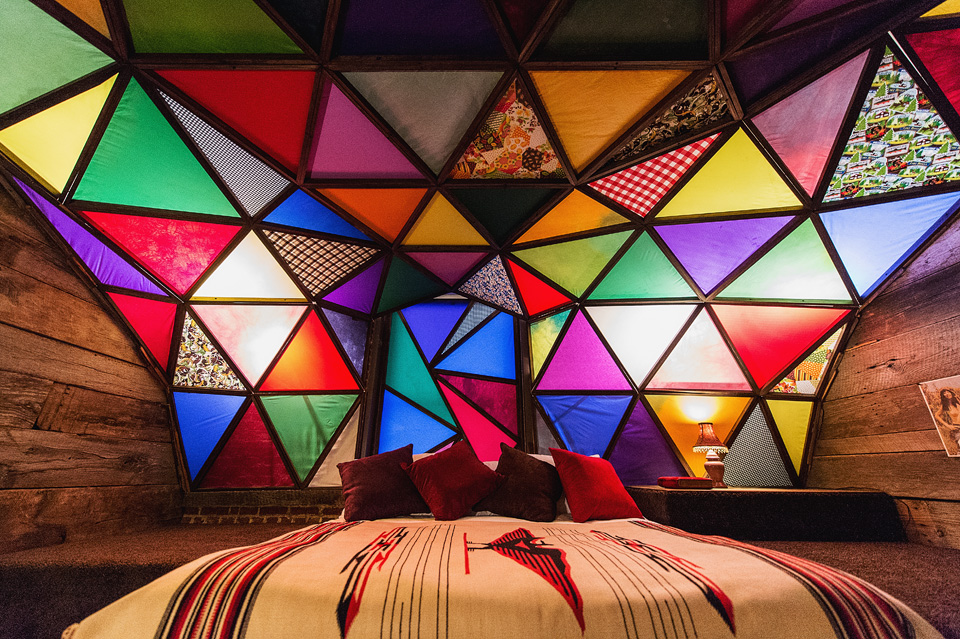In the depths of 21c Museum Hotel Louisville rests a room tucked away beneath the expanse of the hotel and restaurant above. The Bunbury Suite. While having great space inside and being very conveniently located within the bulk of the gallery space of the hotel, the room always posed a bit of a challenge with its basement location and lack of abundant natural light. Early in the spring of 2012, 21c Founder Steve Wilson approached 21c’s Chief Curator Alice Gray Stites with an interesting solution. Turn the room into a “habitable work of art.”
That May, Stites attended an exhibition at Land of Tomorrow – a local gallery and project space in Louisville – and met artists Jonah Freeman and Justin Lowe, a collaborative duo known for their multi-media conversions of the physical environment. Says Stites, “I met Jonah and Justin and they went to the top of my list. Soon after, we approached them with the proposal to consider the space at 21c for one of their immersive, architectural transformations. They were immediately responsive, came for a site visit, and the journey began.” “This is truly a groundbreaking initiative, from both the practice of art-making and in hotel design,” Stites continues. “Because 21c’s mission is to share innovative art with the public, the project was always intended to be experienced by our guests. The artists were not asked to design or decorate a hotel room, they were commissioned to create a functioning work of art.”
And create they did. With Asleep in the Cyclone, Freeman and Lowe have moved us into rural 1960’s Colorado and into the dream of a certain utopian ideal of the time. When one opens the door to the room you almost have a feeling you are Alice falling down the rabbit hole into Wonderland. The work is largely inspired by Drop City, a social project/community that formed in Colorado in the mid-sixties. Started by a group of artists who purchased several acres of land, Drop City was meant to be an artist’s community where everyone was a peer and there were no “bosses.” Inevitably, human nature crept in and hierarchies formed, tensions grew, and the community disbanded. Leaving behind nothing but the domes and zonohedra they built to house themselves in. The free and open society of Drop City may not have stood the test of time but it is the “kind of experience [that] can last for a night,” says Stites. “This is a space that [can be rented by anyone] and when it’s not going to be occupied it can be seen by the public just like our other exhibitions. So I think we are kind of true to the spirit of the free democratic, Drop City republic in that sense. You can come into this space and it’s a dream. It was a dream. It didn’t work out in that reality but you can have it in a parallel one.”
While Freeman and Lowe have created many projects in galleries and public spaces across the world, this is their first hotel room. Says Lowe, “it’s really nice to do site-specific pieces because there is something very special about that. Where you can really respond to the environment as opposed to obliterating it, which is what happens really when we do gallery shows.” They have also responded to the environment by utilizing the city of Louisville and its creative forces. The artists purchased many of the props used in the room from area shops. The wood used to build the “dome” came from a recently demolished tobacco barn. Along with 21c, local designers Drura Parrish and Spencer Dorhman of Parrish Productions were an integral part of the project. They have even enjoyed the team at 21c Louisville. Says Freeman, “the entire hotel staff has been actually quite friendly. [They will pop in and out], curious about the progress down here.”
This may be the first art-installation hotel room for Louisville, but there is always that chance for another here or at other 21c properties around the country. Of the experience, Freeman says “[we are] creating environments or sequences of environments that have a very detailed verisimilitude to what they are referencing. In this case a hippie commune.” Stites concludes, “artists are great problem solvers. If there are challenging spaces in future sites, artists with new ideas could certainly be engaged in a similar process of magical transformation.”
> Want to experience it for yourself? Reserve online now


